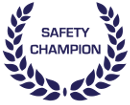To make this terminology slightly more accessible – a ‘near miss’ could simply be called a ‘close call.’ It’s any time that someone in your workplace might have narrowly avoided injury or harm. Sounds like an ok outcome, right? An injury avoided! Great, let’s get on with our work. But actually near misses are worth a closer look.
It may sound laborious and you are probably thinking, ‘Of course, the health and safety people want to investigate that near miss further.’ Perhaps you think this may be a waste of time, effort and money. After all, no one was hurt. But actually near misses – from a safety management perspective – are gold. Why? Well, not only did no one get hurt (yay!) but they are also brilliant opportunities to learn about the hazards and risks in your workplace.
What’s our advice about how to use near miss data?
Essentially, as a business owner or a manager, you are trying to create a workplace that means your people will go home every night happy, healthy and in tact. This means, you need to recognise possible hazards and reduce the risk of injury and harm. So, it’s worthwhile starting to look at near misses as great indications of what hazards need to be addressed to improve safety in your workplace.
Start to build a culture of reporting near misses. If near misses are reported and then properly addressed, you are doing your job to protect the health and safety of your people.
It’s also important to note here that an organisation may be prosecuted in the case of a near miss. Yes, this can be the case even when no one has been injured. Why? Well, in some cases it may be deemed negligent of an organisation to have exposed people to risk – whether the likelihood of that risk is high or low. So, even more incentive to get your people in the habit of reporting near misses.
So how can you promote and improve your near miss reporting?
- Explicitly ask your workers at team meetings of near misses or close calls that they have been involved with, and
- Make ‘near miss’ reporting clear, simple and easy! Not sure how? Consider implementing a health and safety software program like Safety Champion. Safety Champion will allow workers to report near misses, and ensure that these are communicated to key stakeholders in the business to manage.
Once you start to get workers reporting ‘near misses’, don’t forget to establish controls to ensure that the likelihood of the ‘event’ occurring again in the future is reduced. Once you have reduced the potential impact of the hazard, then, you are doing your job – and doing it really well. See – near miss data is awesome and can really help you build a stronger safety management system.














